History of the Mycenaean civilization
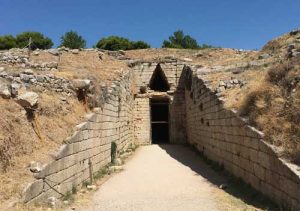
This civilization was the creation of Greek races, known by various names from the sources: Achaeans, Danaans, Ionians, Argives, etc. These Greek tribes, after consolidating their establishments on the mainland, accepted the influences of the other Aegean cultures, especially the Minoan. Then they spread to the Aegean area, the islands, Crete and the coasts of Asia Minor.
During the period of great prosperity they went beyond the borders of the Aegean and settled, sometimes permanently and sometimes occasionally, in Cyprus and on the eastern shores of the Mediterranean.
The most important centers of the Mycenaean world were Mycenae, Argos, Tiryns in the Argolis, Pylos in Messinia, Amykles in Laconia, Orchomenos, Thebes and Glas in Boeotia, Athens, Eleusis, Marathon in Attica and Iolkos in Thessaly. Most centers were established in selected locations which facilitated the supervision of a large area. Their establishment was combined in most cases with the construction of a palace and a strong fortification.
Sources
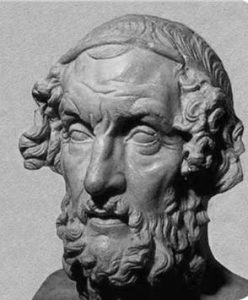
His stories acquired historical significance when a rich merchant, Heinrich Schliemann, made the first excavations in Mycenae (1876). Since then and until today, archaeological research in many parts of Greece and the study of their findings have shed much light on the knowledge of this era.
The culmination of all research concerning the Mycenaean art and culture was the decipherment of the Linear B script by M. Ventris and J. Chadwick (1952). Linear B’ was used by skilled scribes in Mycenaean palaces. The reading of the tablets found at Pylos, Knossos, Mycenae and Thebes showed that Linear B is a syllabic script. But the most important thing is that it validated the Greekness of the Mycenaean culture.
Turned out that its symbols represent words of the Greek language. They actually attribute to an early form of the Greek language, even older than that of the Homeric epics. The information, however, that the signs give us has an accounting content, i.e. lists of objects and assets of rulers or merchants of that time. Names of gods and people known to us from the epics have also been read.
It must be pointed out that until today the signs have not given us a continuous text.
Historical science includes the Mycenaean civilization partly in Greek prehistory or, to be precise, considers it to constitute Greek protohistory.
Research activity
Economic, social and political organization of the Mycenaean world. The closed agricultural economy of the settlements of the Middle Bronze Age was apparently followed by a form of economic relations based on trade. Commercial development, especially after 1500 BC, followed a rapid pace and resulted in the departure of the Mycenaeans to the Aegean. A series of palaces, built on fortified citadels, attest to the economic development of the Mycenaean world.
Εconomic activities
The center of economic activities were the palaces. The majority of the citizens were engaged in agriculture and animal husbandry. A large group consisted of skilled craftsmen (ceramists, carpenters, shipbuilders, coppersmiths, goldsmiths, perfumers, doctors, etc.) and another, also numerous, merchants and sailors.
Social hierarchy
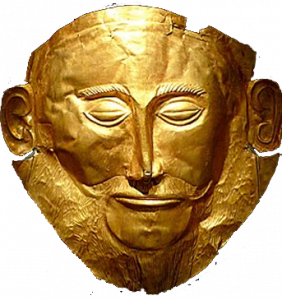
At the base of the social pyramid were the slaves. They were servants who worked for the ruler, officials, priests and ordinary citizens.
The common characteristics presented by the Mycenaean world throughout the area of its spread and which confirm its cultural cohesion would be an indicative element for the organization of a single state.
But it seems that this did not happen. It has been suggested that the country must have been divided into four or five larger and about as many smaller “federal” states, corresponding to the great palaces. It is possible that the individual Mycenaean states were subordinate to the larger palace center, Mycenae.
The Mycenaean state
We do not have sufficient data for the organization of each Mycenaean state, with the exception of the information given by the plaques from the palace of Pylos. Supreme lord, according to the information on the tablets, was the “anakta” , master of the palace from where all power went. Subordinate to him were local lords, district commanders.
The title by which we recognize them on the plaques is laagetas (Ρθλερ οφ τηε πεοπλε). Important persons in the regional administration seem to have been the executors. For the Mycenaeans, the title king was less honorable. This was the name of the head of any group, even the master craftsman of a group of coppersmiths. On the contrary, in the Homeric epics, i.e. the following centuries, the word “king” in the Greek language denotes the supreme ruler.
The expansion of the Mycenaean civilization
The main source of wealth and development of the Mycenaean world was trade, the pursuit of which turned the Mycenaeans to the sea. Until the middle of the 15th c. e.g. a leading role in the Aegean was played by the Cretans – at the end of the same century, however, the Mycenaeans dominated Crete and captured Knossos. They displaced the Cretans from the Aegean and imposed their own maritime rule.
Excavation data proves the existence of Mycenaean establishments or trading posts throughout the Aegean. In the following two centuries, their spread extended beyond the Aegean. The 13th c. e.g. they systematically colonized Cyprus, which belonged to the sphere of influence of the Phoenicians and the Egyptians, contributing to its Hellenization.
They established a Mycenaean settlement in the Phoenician city of Ugarit and expanded their trading activities further south into Palestine and Egypt. Hittite sources also inform us about the spread and power of the Mycenaeans.
Tablets found at Hattusa honorifically refer to the king of the “Ahiyavas,” whom the Hittite king calls brother. It is possible that the Achaeans are behind the Ahiyavas of the tablets. If this is true, then we must accept, as the tablets inform us, that relations between the Achaeans and Hittites were friendly.
However, there were also periods when the Hittite king complained to his brother about the Ahiyava raids in his country. Some Mycenaeans must have been the “Achaivasa” (Achaeans) who, as mentioned in the Egyptian inscriptions, invaded Egypt together with the people of the sea at the beginning of the 12th century. e.g.
It is certain that the Mycenaeans also expanded towards the western Mediterranean. Their products have been found in the Italian peninsula, Sicily, Sardinia and the east coast of Spain. Their sights also turned to the north.
The contacts with the Black Sea, from where they procured raw materials and especially metals, connect them with the famous Trojan campaign. It is possible that with this war the Achaeans sought to control the straits of the Hellespont. Ancient Greek tradition dated the campaign to 1184 BC.
Mycaenean Art and Culture
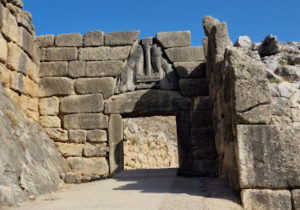
At the same time, they themselves look for precursors of the later Greek classical culture in the Mycenaean period, considering – after the identification of the Mycenaean Linear B writing with the Greek language after its decipherment by M. Ventris – the Mycenaean culture as the “first Greek culture“.
References to art emphasize the influence of Minoan art, but on the other hand they also recognize “pure” Mycenaean features, as, for example, happens in the case of architecture.
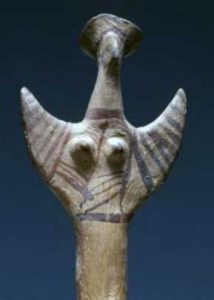
Then it is believed that Minoan Crete collapses and is replaced by Mycenaean rule over the entire Aegean, which results in the phenomenon called the “Mycenaean Common”.
The “Mycenaean Common” does, of course, indicate shared cultural elements, for example in language, manners and customs, religion and material culture, but it may also refer, in addition to a possible community of people with a “consciousness” of common origin, to a society with common demands and symbols for the identities and ideas of its people.
It may indicate, moreover, a mass and standardized production of objects which predominates in relation to the handmade production of small communities and households, a phenomenon somewhat similar to today’s elimination of artisanal, artisanal and “unique” products, from the corresponding standardized and similar industrial ones.
In the above context, two are considered, traditionally, as the main characteristics of Mycenaean art: a) the influence of the art of the Minoan culture that developed in Crete from the 19th to the 15th century. e.g. (ca. 1900-1450 BC), and b) the “warlike”, violent and competitive nature of its content, from the 15th c. e.g. and then, in contrast to the predominance of subjects from nature, but also subjects considered “peaceful” in the corresponding Minoan art.
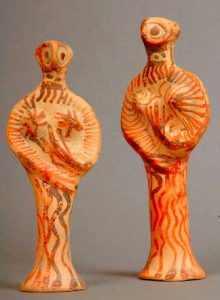
In addition, an important role in the production of objects related to art must have been played by trade, which must have contributed the most to the spread of the “Mycenaean public”.
Figurines, jewelry, amulets, seals, Egyptian scarabs, vessels, weapons, tools, and weights made of various materials such as alabaster, clay, faience, crystal, ivory, marble, copper, gold, and silver were traded throughout the known world of the Late Period of Bronzeage from the western Mediterranean, present-day Italy, Sicily and Sardinia to the eastern Mediterranean of the Egyptians, Hittites, Assyrians and Babylonians and the inhabitants of the Syro-Palestinian coast, with the peoples of the Aegean and Cyprus in the middle.
Architecture
The palaces were protected by walls within citadels where they were built at their highest points. The palaces of mainland Greece were simpler buildings than the Minoan palaces. Mycenae is famous for its enormous walls, the so-called cyclopean walls and the well-known Gate of Lions. What constitutes a landmark in the history of architecture are vaulted tombs.
Painting
As in the Minoan culture, a great development is noted in the art of mural painting. Murals with themes of beautiful women, adorned with jewels, beautiful hairstyles and dresses but also themes with battles, gods, musicians and animals which we find in palaces, rich houses and sanctuaries
Sculpture
An example of sculpture is the relief of the Gate of Lions located in Mycenae. Small clay figurines found in Mycenaean cities are also known.
Mycenae 13th century BC Found in the acropolis of Mycenae and is one of the most important examples of Mycenaean art, this female figure is impressive for its naturalness and vitality.
Angiography
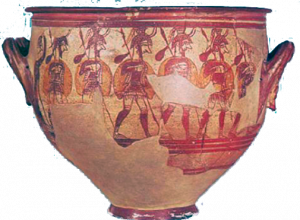
The Mycenaean figurines Φ and Ψ, whose name derives from the similarity of the shape to the two Greek Greek letters, began to be manufactured at the end of the 15th century. and continue to be used until the end of the 12th century BC.
Their origin should be sought in the Minoan tradition. They are small in size with a height of about 10 cm and handmade. They have a bird-like face, and the eyes are either additional clay beads or painted.
The figurines Φ and Ψ are found in sanctuaries as votives, placed on altars or in houses and in tombs, mainly children’s toys. It is a fact that their symbolism was complex and their use probably varied according to the occasion and the place where they were found.
